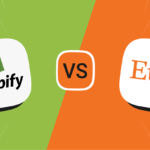For a business that is online choosing the appropriate e-commerce platform is among the most important choices you’ll ever make. Shopify along with Magento are two well-known websites that’ve been in use for a long time, and each one has its distinct advantages and drawbacks. In this blog, we’ll examine the advantages and disadvantages of each platform, and then compare them side-by-side. This will assist you in deciding between Shopify and Magento and which is better suitable for your needs.
Shopify compares to Magento Overview
Shopify and Magento are two of the most popular online stores that are used by a multitude of companies around the globe. Both of them offer a range of functions and features to aid you in quickly and effortlessly establishing the online site.
Shopify is an online platform that is hosted, meaning you don’t have to think about hosting your website. It has a simple drag-and-drop interface, a vast collection of templates and themes as well as a variety of integrated payment processors. It is particularly popular with entrepreneurs and owners of small businesses who want an easy and cost-effective solution to get their store functioning.
Magento On the contrary is an open-source platform that requires the user to create a website. It’s more complicated as compared to Shopify and requires more technical expertise, however, it also provides more customization and flexibility. It’s popular with large companies as well as those who require more sophisticated features.
What is Shopify?
Before you compare the two e-commerce platforms Shopify as well as Magento it is essential to be aware of what each platform is and what it can offer to make a more informed decision can be made between the two platform
Shopify is a comprehensive commerce platform that allows you to begin, expand, and manage your business. The company’s experience and expertise in commerce are derived from the experiences of a multitude of merchants that use their platform. With Shopify merchants can create and modify their online store and sell it in several places, including online mobile, offline brick-and-mortar stores, pop-up shops, and through a variety of platforms, ranging from social media to marketplaces on the internet.
Shopify is entirely cloud-based hosted. This gives customers the ability to manage their business from any location with Internet access. Shopify’s primary product has everything a merchant needs to convert their ideas into a viable business and begin selling. It includes templates to design the look and feel of their store and tools for selling both in-person and online and integrated payment processing the most efficient checkout system on the web SEO-related features, marketing tools, as well as accessibility to Shopify Development tools and APIs to enhance the capabilities of the store.
It also offers a range of powerful enhancements to help merchants expand their businesses using its platform, from more convenient access to capital to more flexible payment options. In addition there is it’s the Shopify App Store has hundreds of applications along with features developed by third-party developers who can customize the store without altering the codes. Additionally, there is a market for Shopify Experts who businesses can employ to create customized solutions for their business.
With Shopify merchants can make commerce anywhere, which includes personalizing the look and feel of their site to provide a unique effortless shopping experience for shoppers as well as marketing and selling their products across multiple channels from a single location, and using tools to establish their own brand and secure their domain and be able to reach every customer.
What is Magento?
Adobe Commerce’s Magento is an open-source platform for e-commerce for some of the leading brands worldwide with a wide range of features. It was launched in 2008 in the year 2008 by Varien and has since grown to be one of the well-known eCommerce platforms. Magento is developed with PHP, which is the PHP programming language and it makes use of various different frameworks, including Laminas (formerly named Zend Framework) and Symfony. It also uses MySQL, the MySQL (or MariaDB relationship-based database management software and which is the PHP programming language as well as components that are part of Zend Framework.
Magento provides a range of capabilities and features. They include a plethora of shopping cart systems, as well as support for different payment options, shipping methods and languages. It also offers a range of options for marketing SEO tools, catalog management instruments and features. In addition, Magento has enterprise-grade database capacity, servers-based Apache Varnish caching, and enhanced static content caching in browsers.
Magento is a great choice for large companies who wish to market their products online. It is a flexible platform for making store modifications as well as outstanding efficiency and safety. With Magento merchants are able to create original, non-plagiarized content to help their stores stand out from other stores.
All in all, Magento is a powerful eCommerce platform that comes with many attributes, features and tools. It is safe and is capable of implementing enterprise-level functions.
Shopify is different from Magento What’s the difference?
After we’ve got an overview of the two platforms, let’s dive into how they differ from one another. The most significant difference is the way that each hosting platform operates. Shopify is hosted, which means that you don’t have to worry about hosting your own site. Magento is, on the contrary, the other hand, is an open-source platform that requires hosting your own site, which means it will require a little more complex and additional steps before a retailer can have their store up and running.
Another major distinction is in the functionalities and features that each platform offers. Shopify is simpler and more straightforward to use, however, it is also less flexible in terms of options for customization and features. Magento however, on contrary is more complicated but also comes with higher-end features, as well as customized options.
The third main difference is with the plans for pricing provided by each platform. Shopify offers lower pricing plans and offers a variety of plans available based on the needs of a business and requirements, whereas Magento is typically more expensive. Let’s look at the benefits and drawbacks of both platforms in more depth.
Pros and Pros and Shopify
Shopify continues to capture an increasing share of online retail market share and with good reason. Its Shopify platform has plenty to offer and is a good choice for a variety of businesses in an array of industries. Here are a few major advantages of making use of Shopify for hosting an online store:
Simple to use by using an easy drag-and-drop interface.
* No coding knowledge is needed for basic stores
* A vast collection of templates and themes
* A wide range of integrated payment processors
* 24/7 customer support
* Comprehensive app store
* Affordable, scalable pricing plans
There are certain drawbacks to the use of Shopify. Here are a few possible disadvantages of Shopify
* Inventory is limited and there are no fulfillment options
* There are only a few customization options
* Some restrictions on international sales
* Not recommended for large-scale companies unless they are in the enterprise plan.
Pros and Pros and Magento
Magento is a dependable and flexible e-commerce platform and is very popular with larger companies. Here are a few main benefits that come with using Magento:
* Highly customizable
* A comprehensive supply and options for fulfillment
* Strong selling capabilities internationally
* A powerful content management system
Like Shopify as well, there are some possible disadvantages of using Magento. Here are a few possibilities Magento pros and cons:
* You must host your own website
* More complicated than Shopify
* Requires additional technical expertise
* No 24-hour customer support and a plethora of support resources
Shopify is a better alternative to Magento The Difference: Features
The two platforms Shopify and Magento offer basic store features that are user-friendly and up-to-date. In comparison with Magento, Shopify is much simpler to set up and use. The two platforms Magento and Shopify have the same basic features including online shopping carts and checkout modules, collections as well as product pages. The major difference is that Magento offers more advanced and intermediate functions that are available within the platform. With Shopify, the functionality is typically only accessible through an app from a third party. With the number of sophisticated apps accessible on Shopify’s app store Shopify application store, the latest technology is able to create a completely new level of online shopping experience.
With the aid of third-party integrations that work with technology partners such as Klaviyo, Yotpo, and Recharge among other companies, Shopify offers excellent marketing capabilities, which include the ability to create email marketing campaigns or provide customers with extremely-converting memberships. Through Facebook, Instagram, and Pinterest you can sell or advertise directly, providing another channel for reaching more of your target market.
The majority of the marketing tools offered by Magento originate from its Marketplace. For email marketing campaigns to be launched for example you’ll need to install an extension like Remarkety, for instance. If you’re looking for authentically custom-designed features, you’ll likely have to depend on the expertise of a web developer when it comes to integrating marketing software, while Shopify offers a variety of marketing tools built-in to aid in the growth of your store. In the end, Shopify has a wider variety of options and features with the aid of Shopify’s App Store. Shopify App Store. There are more than 8,000 apps available in 2023.
Shopify compares to Magento Pay Gateways
The payment gateways as well as processors are the base for each transaction within e-commerce stores. Merchants without payment gateways are unable to accept and process payments from their customers, and all the transaction data associated with it.
Shopify integrates with more than 100 payment gateways and offers lots of flexibility for customers as well as online store owners. It is important to note that different populations in different nations tend to prefer different payment methods as opposed to others and a lot of users appreciate the convenience of using the payment processors that already exist. Every third-party payment gateway has its own pricing structures and accessibility, so using multiple payment methods is generally a good idea as it provides more flexibility for clients. Magento is compatible with PayPal, Authorize.net, Braintree and a few other third-party payment services, but less than Shopify. The most notable thing is that Shopify provides the ability to integrate a POS system, but Magento isn’t. Shopify POS is an excellent option for online stores that also want to sell items in person through pop-up shops or even physical stores.
Although Shopify provides more options with regard to payment processing compared to Magento it is worth taking into consideration the costs of transactions when you use payment platforms, as some are more costly than others. Third-party payment gateways typically charge transaction fees, but Shopify’s own payment mechanism, Shopify Payments, has no transaction fees.
Shopify compares to Magento: Web Development and Coding
When it comes to programming in addition to the expertise needed to develop websites, Magento and Shopify are very different. Magento employs PHP and Shopify uses PHP. Shopify utilizes a proprietary programming language known as Liquid. PHP is a popular server-side language that is widely used as a programming language by e-commerce website developers from all over the world. Liquid is an open-source template language developed by Shopify and written in Ruby. It’s the foundation for Shopify themes. It is employed to store dynamic data in Storefronts.
Each PHP along with Liquid are excellent programming languages that can be used for online stores. PHP is an open-source programming language that offers flexibility and a variety of features, which makes it very popular in web design. Liquid is an underlying language that is used for customizing websites and constructing dynamic websites. It is a safe language that allows you to alter the appearance and feel of websites without altering the code.
The programming language you choose for your store’s e-commerce needs is dependent on your individual needs and preferences. Magento requires more understanding of coding than Shopify to build an entire store from scratch. It is therefore more suitable for businesses that use e-commerce and have access to a skilled developer team.
Shopify vs. Magento Usability
In addition, when it comes down to usability and usability, each Shopify and Magento have an extremely well-engineered and well-designed user interface. Shopify is typically more suitable for novices, whereas Magento is more suited to advanced developers.
Shopify has an intuitive interface, with a drag-and-drop editor that makes it easy to manage inventory, products and inventory. Shopify offers users a vast selection of themes, plugins and other tools to personalize their stores which makes it simple to start with a basic store quickly and easily. Magento however, on the other however, has a steep learning curve, and requires advanced coding expertise to customize and manage the store. Magento also offers fewer free themes than Shopify. It’s worth noting that although Shopify is easier to utilize than Magento its simplicity may restrict how advanced the capabilities are in the beginning as compared to Magento. If developers are on hand and both platforms are used to their fullest potential to make online stores reach their full potential.
Shopify is compared to Magento Price
If it comes to pricing, Shopify offers several plans which range from the Basic plan for $39 a month, the Standard Plan with a monthly cost of $105 and their Advanced plan for $399 per month. Shopify Plus starts at $2,000 per month for enterprise customers.
Magento also has a variety of plans ranging from the Free Community Edition to their Enterprise Edition starting at $18,000 annually. For features, the various plans are generally equipped with greater features and capabilities the higher your spending. Online stores and businesses are able to choose less expensive or more costly plans based on their budget and revenue on both platforms. Yet, Shopify is a winner in terms of overall cost since the various plans are less expensive as compared to Magento counterparts, particularly since the costs for hosting on websites are less and the transaction costs on payment processors (if you are using Shopify payments) are lower with Shopify.
Shopify vs Magento The Security
Each of Shopify as well as Magento are safe platforms and provide a variety of security features that can protect your company. Shopify employs secured socket layer (SSL) encryption that ensures that the data of your customers are secured, and provides two-factor authentication and fraud protection. Magento also utilizes SSL encryption and also offers two-factor authentication and fraud protection as well as PCI compliance. Merchants can be confident that both platforms provide high degrees of safety for the online venture and their clients.
Shopify vs Magento Customisation
It is essential to tailor your store’s design when creating an online store since it demonstrates to potential customers your company’s image and your mission. Stores that are designed and customized well are better positioned to offer a greater rate of conversion and less bounce rates than poorly-designed or custom-made stores. When it comes to customization each Shopify and Magento provide a variety of templates and themes. Shopify offers an extensive collection of templates and themes, while Magento offers more sophisticated customization options.
Magento has more flexibility than Shopify in the sense that it allows you to personalize your store the way you would like. Shopify provides a larger selection of themes as compared to Magento as well. You don’t have to use code to modify Shopify themes. Shopify’s free Shopify themes are usually more up-to-date than the basic themes provided by Magento Open Source, despite the fact that the amount of no-cost Shopify themes is considerably lower than Magento Open Source.
The reality is that Shopify premium themes begin at $80 whereas Magento-priced themes cost $1 placing Shopify at an advantage in this field. With Shopify merchants aren’t restricted to pre-designed templates. They are also able to use customized Shopify themes created specifically for their store. The two platforms Shopify and Magento offer a variety of responsive templates that are both premium and free in order to meet the contemporary need for responsive websites (a design that works across the many commonly used devices that people use to connect to websites).
The options for customization offered by Magento are as great as they come because every single part of its code is open-source, and you can alter it however you want. As was stated, Shopify is superior in this regard by providing an easy, menu-driven way to change the core features of your store like colors, fonts and more. quickly and quickly. But only those with a solid background in HTML/CSS and web development can take advantage of this flexibility to personalize.
Furthermore, Shopify provides a theme editor that lets you modify the look of your theme. The editor allows you to block out zones so that you can make changes to your theme without needing to replicate the design or employ staging servers.
The drag-and-drop features available on Shopify provides are great to organize the content on your site. While it’s not a drag-and-drop tool but it does provide an easier design interface as compared to Magento. Shopify is also able to manage updates and patching for clients, while Magento needs you to manage this manually. Regarding design, each Magento and Shopify have their own distinct styles. But, Shopify provides a much more simple design experience for those who are just starting out starting out. Merchants using Shopify who wish to provide an experience that is more personalized for their customers may require the assistance of an entire team comprised of internet developers as well as web-based developers in order to create a unique shop that stands out from the crowd.
Shopify compares to Magento Support
Support-wise, Shopify provides excellent customer support, including email, phone and live chat support in addition to Shopify Acadamy library of resources as well as a the Merchant Success Program (For businesses who are on Shopify Plus). Shopify Plus Plan). Shopify also provides informative tutorials as well as a huge variety of third-party applications and plug-ins. However, Magento offers limited customer support, which isn’t 24-7. Yet, Magento does provide a quite extensive knowledge base and forums. This is why Shopify wins for smaller companies that need additional assistance or support in the event of issues, whereas Magento could be more suitable for larger companies with a long history.
Shopify vs Magento in the area of inventory and shipping
One of the most important aspects of selling physical items on e-commerce sites is shipping and managing inventory. Shopify is a powerful point-of-sale (POS) software that provides the ability to track inventory, unification of analytics and management of staff capabilities. Merchants can control inventory levels and review comprehensive sales reports using Shopify. Magento offers an easy inventory management system similar to Shopify. However, it is distinct with its sophisticated features. Magento offers more robust inventory and order management capabilities than Shopify. The extensions and custom solutions allow you to create an infinite number of different types of products and categories, as well as include custom fields in your checkout procedure.
Both platforms offer flexible and efficient solutions to calculate shipping costs. If you’re looking to be as precise as you can for your customers, Shopify also interfaces with various dropshipping services (including estimations of delivery) as well as more accurate shipping calculators.
Discounts and coupons are a feature not available in Magento’s Lite plan, which makes it an underdog in this contest but it’s offered in all other tiers. Magento has built-in functions to generate discount coupons and calculations.
In terms of inventory, your store will be stocked with an unlimited number of products with each of Shopify plans. You can create and sell an unlimited number of items with Magento. Both systems allow you to build collections and products however, Shopify is the winner due to its direct interactions with dropshipping inventory software such as Oberlo.
It is important to note that due to the fact that Shopify is a fully-managed and hosted platform, it is often more easy to add more images and products for an online shop. If you are adding more than you can count on your Magento store the hosting (server) efficiency and website loading speed can be a problem when you have high volumes of volume of traffic and purchases.
Shopify Vs Magento Apps and Plugins
The two Shopify and Magento provide a variety of applications and plugins that improve the capabilities that your shop. Shopify has an extensive app store, and Magento provides a broad range of integrations from third parties.
The Shopify applications can help you in many ways to enhance and improve the capabilities of your store and also extend the longevity of your business since it lets merchants innovate as well as compete against other online stores more efficiently. With apps for loyalty programs, accountancy and email marketing, and more, the Shopify App Store is continually growing.
The benefit is that you won’t need to install unnecessary programs that can damage your website due to the fact that Shopify regulates its app store very effectively. The popularity in Shopify’s App Store Shopify App Store gives it an advantage over Magento. customized apps can be created completely custom to maximize the potential of online stores.
Shoify against Magento Shoify vs Magento: International Selling
For international sales, Shopify and Magento both provide a wide range of choices. Shopify doesn’t immediately offer extensive multilingual options. It does, however, Shopify Markets along with Shopify Markets Pro along with Shopify paid and third-party apps can be used to build fully multilingual shops. Shopify offers the possibility of customizing your theme to work with a variety of languages. To do this, you’ll have to engage an experienced Developer for Shopify. Magento is a native store and has a distinct advantage due to the fact that it comes with multilingual capabilities built-in however both are able to be effective in selling internationally after a bit of tweaking. For comprehensive instruction on ways to market internationally through Shopify make sure to read our comprehensive article!
Shopify compares to Magento: Content Management Systems
Shopify provides an ever-growing array of e-commerce Content Management System (CMS) capabilities, which allow users to edit, create and manage content. It also offers options for SEO-friendly blogging and the management of various languages, which are vital for positioning on search engines like Google or Bing. However, Shopify’s CMS isn’t the ideal solution for sites with lots of content, blog documents, or large amounts of content. In addition, it can’t handle the entire needs for content in a business in the present.
Magento has a robust content management system with easy-to-use page builders and support for a variety of kinds of content, and an WYSIWYG editor. It’s highly adaptable and is able to handle an array of products. Magento is also a great platform for tools for managing content which makes it an excellent option for launching an online store. Shopify provides a simpler interface as a feature integrated into it.
Shopify against Magento Comparison of Shopify and Magento: Conclusion
Overall two Shopify and Magento provide unique solutions to create and manage your online business. In the end, the decision between Shopify and Magento depends on your requirements and objectives. Shopify is clearly the winner with regards to the user experience and customer support and customer service, whereas Magento has more options for customization and marketing options. Shopify is a lot simpler and more user-friendly to use and comes with the availability of a reasonable pricing system however, Magento is more complex, but it also has more advanced features and customization options.
If you’re a smaller business owner or entrepreneur searching for a simple platform with a reasonable pricing plan and a user-friendly interface, then Shopify is likely to be a great option. If you’re an enterprise with more advanced capabilities and customization options and options, then Magento may be the better option.
In this comparison of Shopify against Magento we’ve analyzed the main differences between these two platforms, such as features usability, usability, coding capabilities, customization applications and plugins, support payments processors, international sales pricing inventory, fulfillment and other comparatives between both platforms. We hope this post will help you determine the best e-commerce platform for your company! If you’re thinking of switching from Shopify to Shopify or even building a Shopify store from scratch Don’t be afraid to connect with Invints now.











